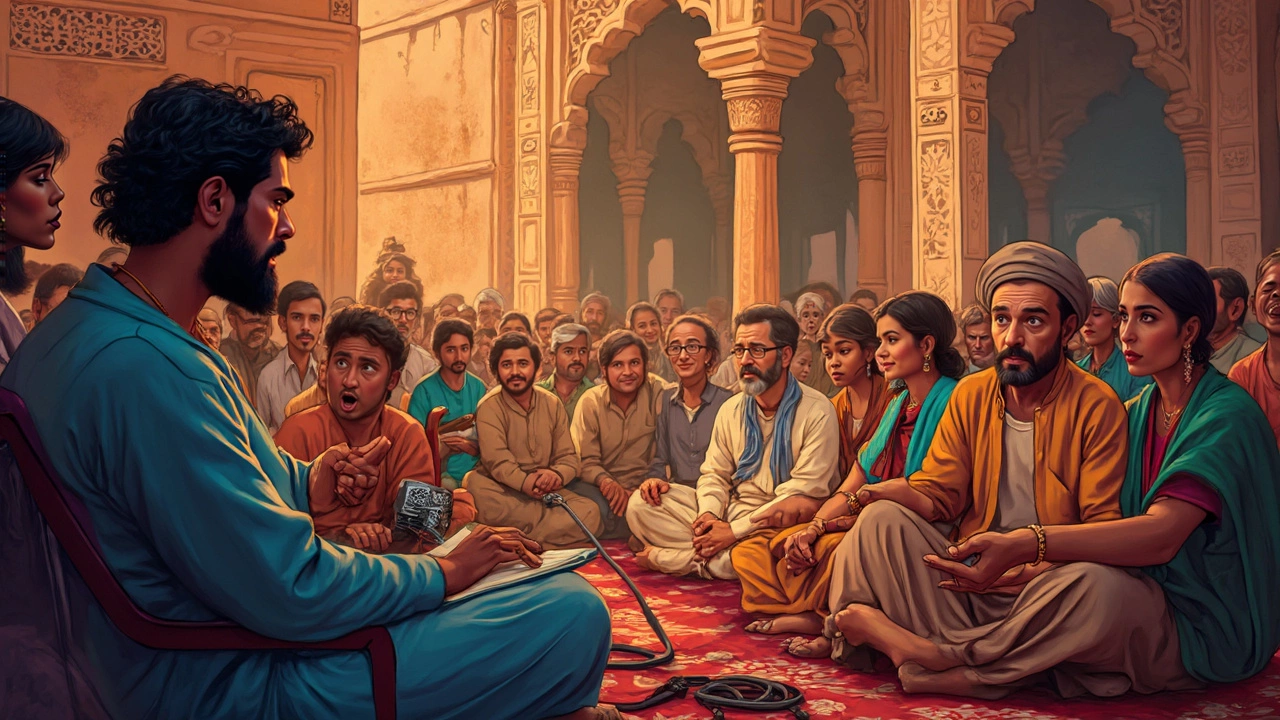In the vibrant world of Urdu poetry, there's a delightful gem that often goes unnoticed—Takhmis. This is a form that's all about creativity and connection, crafting a 5-line poem that plays beautifully with existing couplets. At first glance, Takhmis might seem complex, but it holds a simplicity that's captivating once you dive in.
So, what makes Takhmis stand out in the realm of Urdu poetry? It's the art of embellishing a famous couplet by adding three original lines before it, creating an intriguing narrative or emotional journey. This interplay not only showcases the poet's creativity but also their respect and admiration for the original work they're building upon.
Imagine taking a couplet from a renowned poet like Mirza Ghalib or Faiz Ahmed Faiz, and adding your own twist with three lines that expand on or contrast with the couplet's theme. It's a form that invites you to engage deeply with the poem, bringing both your voice and that of the greats to the fore.
- Introduction to Takhmis
- Origin and History
- Structure and Format
- Famous Takhmis Authors
- Takhmis in Modern Urdu
- How to Write Your Own Takhmis
Introduction to Takhmis
When you first hear about Takhmis, it may sound a bit mysterious, but it’s actually one of the most creative forms in Urdu poetry. Takhmis involves taking a well-known couplet—or ghazal—and adding three original lines in front of it. This technique doesn't just add lines; it reshapes the original thought, giving it new dimensions which can be deeply personal or strikingly different.
Takhmis is more than just an additive process. As Ustad Qamar Jalalvi once pointed out, "
Takhmis is the art of respecting tradition while expressing individuality." The fun lies in the challenge: balancing your creativity with the legacy of established poets, crafting something new while paying homage to literary tradition.
Why Choose Takhmis?
The appeal of Takhmis lies in its blend of structure and freedom. For budding poets, it provides a solid foundation (the couplet) while allowing ample opportunity for expression through the additional lines. It’s perfect for those who are exploring their poetic voice but want to root it in something familiar.
- Creative Challenge: Come up with three lines that flow into a renowned couplet.
- Embrace Diversity: Use this form to express varied themes, from romance to rebellion.
- Respect Legacy: Engage actively with the works of established poets.
Examples in Action
Diving into historical examples, we see how poets like Mir Anees turned Takhmis into an art form. By using classic themes and modifying them with fresh perspectives, he managed to not only honor previous works but breathe life into them anew.
So, whether you're a poetry enthusiast or a curious reader, exploring Takhmis can open new avenues of thought and creativity. You don’t just read or write; you interact, combine, and experiment, pushing boundaries within a set framework. It’s a poetic dance of tradition and innovation.
Origin and History
The delightful poetry form of Takhmis has roots that dig deep into the rich soil of Urdu literature. Historically crafted in the golden era of Urdu poetry, it's a testament to the inventiveness of poets who would build upon and pay homage to existing works. The essence of Takhmis thrives on the beauty of intertextual dialogues, where poets venture into adding their flair to couplets.
Understanding the origins of Takhmis goes hand-in-hand with appreciating the broader history of Urdu poetry. This genre experienced significant growth during the Mughal era, a time when poetry wasn't just an artistic expression but a vital part of court life and culture. Poets such as Mir and Ghalib set the stage, and their captivating couplets often became the canvas on which others penned their Takhmis.
Interestingly, many early Takhmis were written as a form of tribute to the masters or as exercises in demonstrating poetic prowess. This form became popular especially in gatherings known as 'Mushairas,' where poets recited their pieces to enthusiastic audiences.
India's rich tapestry of linguistic and cultural exchanges also played a pivotal role. Various literary influences, especially from Persian poetry, contributed to the distinctive nature of Takhmis. Persian's influence is evident not just in the themes but also in the aesthetics and techniques used in these poems.
This enduring form has managed to stay relevant, even as it crossed regional and temporal boundaries. As a living tradition, Takhmis continues to evolve, inviting new voices to blend tradition with contemporary expression. Its history isn't just confined to books; it's alive at poetry events and in the hearts of Urdu poetry enthusiasts across the world.
Structure and Format
The structure and format of a Takhmis might seem like a puzzle at first, but it's actually pretty straightforward once you get the hang of it. A Takhmis is essentially a poem consisting of five lines. What makes it unique in Urdu poetry is how it creatively expands on an existing couplet, usually called a 'Matla'.
The way it works is, you take a well-known couplet, often from a revered poet, and build three lines before it. These new lines should harmonize with the original couplet's rhythm, meter, and sometimes even its rhyme. The goal is not just to fill space but to enhance or alter the meaning and emotional impact of the couplet.
Step-by-Step Breakdown
- Select a Couple: Start by choosing a couplet that resonates with you. It could be anything from classical to contemporary.
- Craft Three Lines: Add three of your own lines before the chosen couplet. These lines should flow naturally into the original couplet.
- Maintain Rhyme and Meter: Make sure your lines match the meter and rhyme scheme of the couplet, which keeps the poem cohesive.
This structure not only honors the original poet but lets you showcase your own artistic flair. Among the community of short poems, this form invites you to be both a poet and a collaborator, playing with words across time.

Famous Takhmis Authors
Diving into the rich world of Takhmis, there are a few standout poets who've truly made their mark. These authors have not only embraced this art form but have elevated it with their innovative approach. Their works serve as an inspiration for new poets venturing into this captivating form of Urdu poetry.
Mir Taqi Mir
Regarded as one of the pioneers and a giant in Urdu literature, Mir Taqi Mir has masterfully used Takhmis to weave emotional intricacies. His ability to set a whole mood within just five lines is astounding. The depth and ease with which he creates these verses makes him a timeless figure in this tradition.
Allama Iqbal
Though primarily celebrated for his ghazals and philosophical poetry, Allama Iqbal also ventured into Takhmis. He often infused his spiritual and philosophical insights into this format, bridging traditional poetic elements with contemporary thoughts of his time.
Firaq Gorakhpuri
Another name that shines brightly is Firaq Gorakhpuri. Known for his romantic and evocative style, Firaq used Takhmis to such an expressive effect that readers often find themselves lost in the imagery and heartfelt emotions he conveys.
These poets not only contributed significantly to the Takhmis tradition but have encouraged an array of modern poets to explore and experiment within this form. Their legacies continue to inspire and guide budding poets in the world of Urdu literature.
Takhmis in Modern Urdu
While traditional forms of Urdu poetry like Takhmis have their roots deeply planted in history, they're far from relics of the past. In today's literary world, they continue to flourish, merging with modern styles and themes. You might be surprised to learn that this classic form is enjoying a sort of renaissance, both among purists and innovators in Urdu literature.
Why is this happening? One big reason is the internet. With platforms like Instagram, Twitter, and dedicated poetry forums, poetry has seen a boom. This means poets are eager to experiment with older forms like Takhmis and tailor them to fit contemporary themes—think social issues, love in the digital age, or even memes!
What's particularly exciting is how emerging poets are using Takhmis to pay tribute to legendary poets while making a statement of their own. For instance, incorporating lines from a celebrated poet allows them to draw a direct line from the past to the present, creating a continuity that's both respectful and revolutionary.
Engagement Through Workshops and Competitions
In recent years, there's been an uptick in workshops dedicated to traditional forms like Takhmis, not just across India, but worldwide in diaspora communities. These workshops are a fantastic way for budding poets to refine their craft, understand the nuances, and engage with mentors.
Moreover, poetry competitions frequently feature themes around classical forms, including Takhmis. Offering a platform for poets to showcase their work, these events are helping to cement the relevance of Takhmis today.
Notable Figures Keeping Takhmis Alive
Some poets and educators are pivotal in keeping this short poem form alive in modern times. Prominent writers such as Gulzar and modern Urdu influencers have highlighted Takhmis in their works or teachings, enhancing its appeal and accessibility to the younger generation.
| Platforms | Impact on Takhmis |
|---|---|
| Broader reach for sharing short poems, including Takhmis. | |
| Workshops | Hands-on learning and creative exploration of poem forms. |
| Competitions | Encourages new and unique adaptations of Takhmis. |
So, whether you’re a poet, a reader, or a curious soul, give Takhmis a try. Who knows? You might find yourself captivated by this delightful dance between history and creativity.
How to Write Your Own Takhmis
Writing your own Takhmis can be a rewarding experience, blending your creativity with a piece of classic Urdu poetry. Let's break it down into simple steps to get you started on this poetic journey.
1. Choose Your Base Couplet
Start by selecting a couplet that resonates with you. It could be from iconic poets like Mirza Ghalib or someone whose style you admire. The couplet should have a theme or emotion you can connect with or wish to expand upon.
2. Understand the Theme
Dive deep into the couplet's meaning. What is the essence? Is it about love, loss, nature, or philosophy? Grasping the underlying theme will provide a solid foundation for your additional lines.
3. Craft Your Lines
Now, it's your turn to get creative. Compose three lines that will precede the original couplet. These lines should not only rhyme but also complement or provide a new perspective on the existing couplet's theme. Here's a simple structure you can follow:
- First line: Introduce a thought or imagery.
- Second line: Develop the scenario or emotion.
- Third line: Lead into the existing couplet seamlessly.
4. Focus on Rhyming Scheme
Takhmis requires attention to rhyme and meter. Ensure your lines adhere to the same rhythmic pattern as the couplet. This cohesion is crucial to maintain the flow and music of the poem.
5. Review and Refine
Once your lines are down, read them alongside the original couplet. Does it flow? Does your addition enhance the meaning? Tweak the lines until they feel just right. Don't hesitate to seek feedback from someone familiar with Urdu poetry.
Writing Takhmis is a fantastic way to engage with Urdu poetry while expressing your unique voice. Whether you're a seasoned poet or a curious beginner, give it a try and discover the joy of this poetic form.
